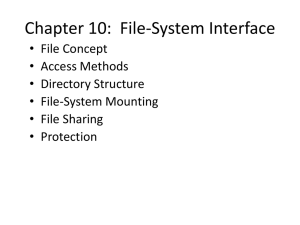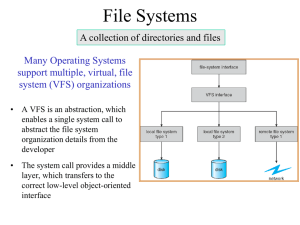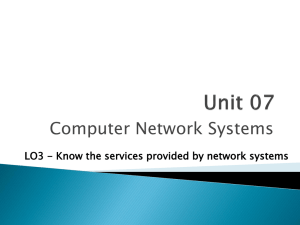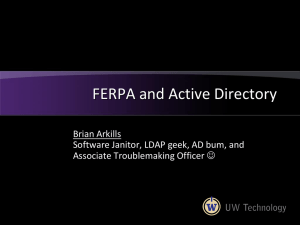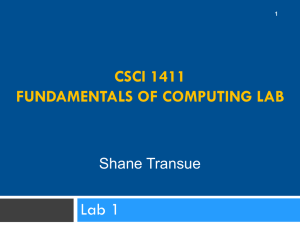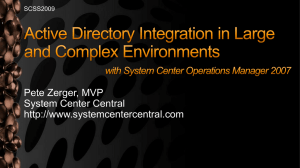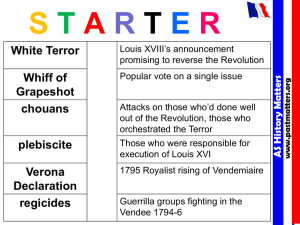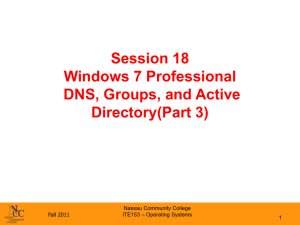identityconference_vds_kogit
advertisement
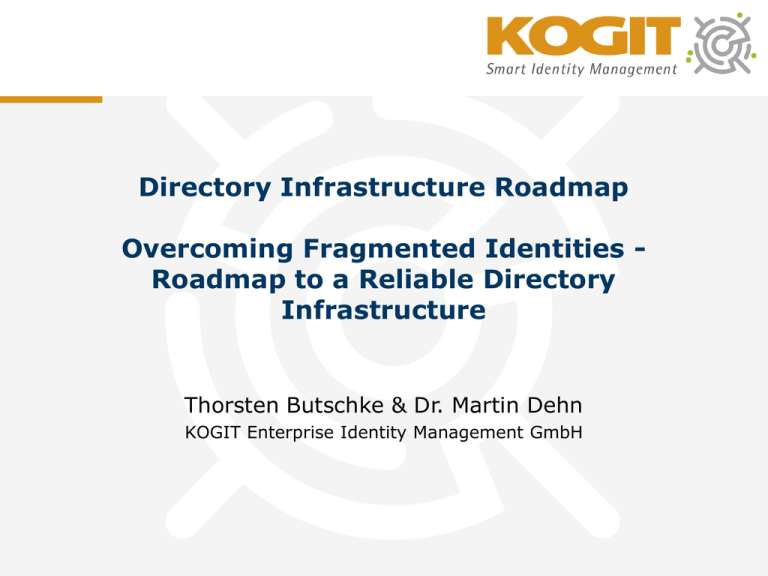
Directory Infrastructure Roadmap Overcoming Fragmented Identities Roadmap to a Reliable Directory Infrastructure Thorsten Butschke & Dr. Martin Dehn KOGIT Enterprise Identity Management GmbH Agenda History of Directory Services From X.500 to LDAP Meta-Directory Approach Virtual-Directory Approach Virtual Directory Use Cases Application Integration Simple Schema Mappings Building a Virtual Tree Virtualization of Multiple Identity Sources Adding Intelligence Using Business Logic Maximizing Directory Infrastructure Performance Enhancing Reliability Vendor Overview From X.500 to LDAP A short introduction to directory services in IT infrastructures Promises & Reality Meta-Directory Approach Administrator User Metadirectory Service UNIX NIS SAP /HR Lotus Notes Microsoft ADS UNIX Administrator SAP/HR Administrator Notes Administrator W2K Administrator The Objectclass Issue • there is no standard definition for at least person/user objects in LDAP directories • there are implementation-specific classes like inetOrgPerson (Netscape, Sun, OpenLDAP) ePerson (IBM), User (MS ActiveDirectory) • how should LDAP clients be built to support these variety? • what if you deploy a new application which needs a type of object class not defined in your enterprise directory? The Namespace Issue • various namespaces are possible in directories • there is no standard for the RDN (identifier) of user objects AGAIN • how should LDAP clients be built to support these variety? • what if you deploy a new application which needs a distinct RDN not defined in your enterprise directory? Overcome the Disadvantages of a Meta Directory with a Virtual Directory Meta Directory • same data stored twice • synchronizations need a lot of time – could take longer than 24 hours in large environments • e. g. a HR synchronization – access to a snapshot of the past instead of live access to the data Virtual Directory • data stored only once • live (real time) access to the data • Prepare the object class and RDN you need! Virtual Directory Approach Clients Optional LDAP Directory Virtual Directory Connector Connectors JDBC / ODBC JNDI / ADSI / OLEDB J2EE CA Applications Databases Virtual Directory Workflow Agenda History of Directory Services Meta-Directory Approach Virtual-Directory Approach Virtual Directory Use Cases Application Integration Simple Schema Mappings Building a Virtual Tree Virtualization of Multiple Identity Sources Adding Intelligence Using Business Logic Maximizing Directory Infrastructure Performance Enhancing Reliability Vendor Overview Intranet Authentification (1) Task Definition • the Intranet is a web portal • authentification is done via an access manager • the access manager stores the users in its own LDAP repository with its own LDAP schema Intranet Authentification (2) Request Content Content Portal Request Authentification Create Create Update Update Delete Delete User VDS Company Directory Decision Accessmanager Intranet Authentification (3) Problems • the class name of the user object is different in the access manager and the company directory • the access manager schema contains attributes, that do not exist or have a different name in the company directory • typical problems if you would like to change the schema of the company directory – problems with existing installation and existing client applications – a lot of organizational discussions Intranet Authentification (4) Implementation (1) • configure the access manager to use VDS as directory • create static content inside the directory • extract company directory schema • map user objects from the company directory to the user object of the access manager directory schema • map attribute names • add – static attributes that do not exist in the company directory – dynamic attributes and values via scripts • link objectclass in the virtual tree Intranet Authentification (5) Implementation (2) Intranet Authentification (6) Benefits • no changes of organizational processes in the company directory • no additional user management processes in the access manager LDAP directory • fast implementation and configuration – only basic scripting skills necessary • reuse of existing user data – no synchronization Intranet Authorization (1) Task Definition • the intranet is a web portal • the authorization is done via group memberships in a directory • there are several user directories – in different branches – from different vendors Intranet Authorization (2) Problems • the portal software could only be connected to a single directory • each directory uses its own schema – objects • user (AD) • inetOrgPerson (eDirectory, OpenLDAP) – attributes • memberOf (AD) • groupOfNames (eDirectory) • posixGroup (OpenLDAP) Intranet Authorization (3) Implementation • decide which schema you want to configure to the portal software (AD in our case) • map the objectnames of all directories to the AD objectname • map the attributes • use scripts for complex mappings – in OpenLDAP the group membership is a name, in AD its a DN • link all directories into the virtual tree Intranet Authorization (4) • OpenLDAP – posixGroup=Marketing • AD: – group=cn=Marketing,ou=groups,dc=mycompany • Script: OpenLDAP->group= „cn= “ + [Possixgroup] + „,ou=groups,dc=mycompany“ Intranet Authorization (5) dc=extern,dc=mycompany IS Interception Script Virtual views ou=de - user - group IS IS ou=dk - user - group Schema mappings IS IS ou=cz - user - group IS IS ou=sk - user - group IS IS inetOrgPerson renamed in user inetOrgPerson renamed in user groupOfNames renamed in group possixGroup renamed in group ou=uk - user - group IS IS ou=nl - user - group Backends AD AD eDirectory Open LDAP AD AD DE DK CZ SK UK NL IS IS Intranet Authorization (5) Benefits • no changes of organizational processes in the company directory • fast implementation and configuration – only basic scripting skills necessary • reuse of existing user data – no synchronization, no organizational changes • products of different vendors can coexist – no migration necessary Global Directory (1) Task Definition • a global directory should be established • data already available in various directories – databases – directories • flat file is also a possible form of directory – e. g. HR export Global Directory (2) LDAP Oracle MySql Global Directory (3) Problems • access to the data via different technologies (LDAP, CSV, SQL) using the LDAP protocol • consolidation of user data in one object could be done easily in the VDS if UID‘s are the same in each source • a synchronization tool is necessary if the UID‘s have a different syntax in each source Global Directory (4) Implementation (1) • virtualization of flat files and databases • link objects based on one attribute Global Directory (5) Link Based on Attribute LDAP View VDS View Oracle View LDAP:mail = Oracle:mail MySQL View LDAP:mail = MySQL:mail Linked based on attribute „mail“ Global Directory (6) Identity View Global Directory (7) Implementation (2) • virtualization of flat files and databases • create a database with an entry for each user – unique id – links to each record of the person in the various sources • create an attribute or transform an existing attribute to match the unique id from the database in the virtual views of the sources Global Directory (8) Creating a Unique ID Global Directory (9) Links to Sources Global Directory (10) Synchronization Global Directory (11) Identity View Global Directory (12) Benefits • access via one single protocol • consolidation of user data in one object • synchronization only needs to synchronize the link, not the data Agenda History of Directory Services Meta-Directory Approach Virtual-Directory Approach Virtual Directory Use Cases Application Integration Simple Schema Mappings Building a Virtual Tree Virtualization of Multiple Identity Sources Adding Intelligence Using Business Logic Maximizing Directory Infrastructure Performance Enhancing Reliability Vendor Overview Maximizing Directory Infrastructure Performance • use connection pools – connections to the sources (back-end) – connections form the client to the server (front-end) • use caches – query & entry caches – memory cache – persistent cache (save data on the hard disk) – cache refresh • triggered by a scheduler • triggered by a message bus Enhancing Reliability Through LDAP Routers • provide failover functionality • provide load balancing functionality • available as – software – hardware LDAP Routing and Caching VDS VM Ware Image Router 3 8 Router Instance Access Manager Cache 4 AD1 2 5 3 1 6 9 8 Router Instance JMS 7 AD 3 User VDS 8 Router Instance 10 11 NDS 3 8 Poral Router Instance OpenLDAP AD2 Agenda History of Directory Services Meta-Directory Approach Virtual-Directory Approach Virtual Directory Use Cases Application Integration Simple Schema Mappings Building a Virtual Tree Virtualization of Multiple Identity Sources Adding Intelligence Using Business Logic Maximizing Directory Infrastructure Performance Enhancing Reliability Vendor Overview MaXware Virtual Directory supported protocols: • LDAP, DSMLv2, SPML, transformation API for inbound protocols supported back-ends: • JNDI, JDBC, Java Adapter API caches: • in memory cache scripting languages: • Java (adapter), XML (configuration) supported platforms: • Java application other features • software load balancing • GUI oriented Oracle Virtual Directory (Former „Octet String“) supported protocols: • LDAP, SQL, DSML, XSLT supported back-ends: • LDAP, NT, database, local store, Java API for adapters persistence: • local data store caches: • in memory cache scripting languages: • Python (transformations) and Java (adapter, routing) supported platforms: • Java Application Other features: • routing rules • load balancing • code oriented (embedded in ECLIPSE) Symlabs supported protocols: • LDAP, SOAP, Radius, SNMP, SIP supported back-ends: • LDAP, SQL, Radius, SNMP, SIP, SOAP persistent: • memory • database scripting languages: • proprietary scripting language (DirectoryScript) supported platforms: • AIX, HP/UX, Linux, Solaris >8 (Sparc & Intel x86), Windows other features • written in C Radiant Logic supported protocols: • LDAP, DSML 2.0, HTTP/ SOAP, SAML 1.1, and SPML 1.1 supported back-ends: • LDAP, ADSI, and JDBC. Java API for custom connectors persistent: • memory • local store caches: • query & entry cache • persistence cache • memory cache scripting languages: • Dynamic Java (scripts), Java (adapter) supported platforms: Java application other features: • optional Synchronization Services • software LDAP router and load balancer • GUI oriented Penrose (Open Source) • • • • reuses the Apache Directory Server worth a look excellent use cases documentation reuse of ECLIPSE Questions ?

